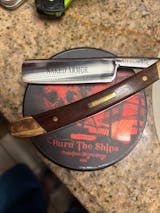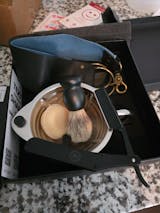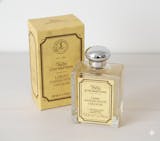How to Remove Rust from a Straight Razor

If your razor is not sharp enough, it may tug on your skin and may leave some nicks and bumps on your face. Sometimes, shaving may involve cuts, which can lead to complications when exposed to a rusty razor.
This, then, makes it our top priority to make sure to remove all those rusty spots.
Hence, in this article, we will let you know everything there is to know about straight razor restoration:
Preventing Rusts On Razor Blades
It is always best to prepare before the storm comes. Fixing its ruins afterward is more troublesome. So, as much as possible, do all the means to protect your razor from rust. The most effective method is cleaning it properly. There are two simple ways to prevent yours from rusting, which are the following:
-
CLAYGO: Clean It As You Go
The first step is to clean your razor after every use. Cleaning could involve simply rinsing the blade, removing all the hair, shaving cream, dead skin, and all the other materials attached to it as you were shaving.
You can also go the extra mile and rub it with a cloth damped in 70% isopropyl alcohol to kill off any disease-causing bacteria that may be hanging out on your blade’s surface.
After rinsing your straight razor, make sure to wipe it with a clean rag to remove all moisture. Then, use a hairdryer to dry it off completely.
Meanwhile, here are some dos and don’ts of cleaning a straight razor that you need to keep in mind:

- Do strop your blade before shaving
- Don’t wet the scales
- Do clean the razor blade regularly
- Don’t leave razor in a wet or moist place
- Do rinse the razor with the soapy water
- Don’t forget to lubricate the razor with oil
- Do wipe the blade with few drops of alcohol
- Don’t forget to store in a dry place like a razor stand
Cleaning a straight razor may seem straightforward; wash it clean, and that is it. But there is more to it if you genuinely want to keep your blades from getting rust. -
Keep It Dry

When you use a razor stand, your straight razor can be thoroughly dried and be far away from the germs and bacteria in your sink.
The second step is to keep the razor away from major sources of moisture, such as the bathroom. However, there is no guarantee that it will not rust if you do not put it in the bathroom. The key to keeping it away from moisture is to let it rest in a well-ventilated area with enough air circulation and less humidity.
Another way that could subject your razor to moisture is if you put it in the sink since it is directly in contact with the surfaces that would often get wet. So, it will be a good investment for your razor to have its stand, like our Silverback Straight Razor Stand.
The takeaway is that overexposure to moisture will cause your straight razor’s demise. So, as soon as you finish using your razor, clean, sterilize, and dry it to prevent rust formation.
Straight Razor Blade Oil and Balm
-
Blade Oil
Aside from cleaning your blades and keeping them away from moisture, applying oil on the blade after using it is another way to keep rusting at bay. You just have to make sure that your blade is completely dry before applying the oil. Putting oil on a damp blade will trap the moisture and trigger the metal to oxidize.
-
Blade Balm

Naked Armor's Beard to Blade Balm is the pure, natural, organic answer to keep your blade rust-free and clean.
Another option for protecting your blade from rust is using a balm. Like oil, applying a blade balm on the thoroughly dry blade may preserve the blade until your subsequent usage. You can get the most benefit, especially if the balm you are using is pure and free from any chemicals, which may be harmful to your razors and face.
Naked Armor's Beard to Blade Balm can protect not just your blade but your face and beard as well. We made it for your beard, face, and your blade. Hence, you can apply it to your face, body, hand, and beard for moisturizing protection.
You can also apply this all-purpose balm to your razor and leave it on until your next shave to maintain the quality of your blade and protect it from external factors that can cause corrosion. Our Beard to Blade Balm is simply a convenient and practical way to ensure that both your beard and your razor stay in shape.
How To Remove Rust Spots On Your Razor
If, despite all the pampering, the inevitable comes and rust spots show up on your razors, here are some home remedies that you may try out to remove rust from your straight razor. Home essentials such as lemon, salt, vinegar, and baking soda may be able to help you get out those spots that hinder your blade from performing well.
Here are the things you need to know how to restore a straight razor when rusts form:
-
Lemon
Lemon is one of the best natural cleaners because of its natural acid content. The acidity of the lemon can break down iron oxide or rust.
To use lemon in removing rust from a straight razor, you must first soak the blade in half of a lemon extract or juice for 30 seconds to one minute. If your straight razor has a wooden handle, it would be better not to include it in the process as the acid may cause damage to the wood instead.
After that, sprinkle sea salt on the other half of the lemon and scrub off the rust spots in the blade. When all the rust spots are gone, rinse the blade thoroughly in running water and dry it off entirely before keeping it.
-
White Vinegar
Vinegar is also a suitable cleaning agent. It is more effective with salt because the latter increases the potency of the vinegar’s acidity, making it capable of removing rust.
You can submerge the blade in vinegar for 30 seconds to one minute. Again, it is best to exclude its wooden handles from the process. Then, make a vinegar and salt mixture and rub it on the blade using a toothbrush until all the rust spots are gone. To finish it off, you will rinse it thoroughly in running water and dry it off entirely before keeping it.
-
Baking Soda
Also known as sodium bicarbonate, baking soda is famous for its versatility since it is a baking ingredient. However, aside from that, it is also a good cleaner for different surfaces.
Baking soda is a salt that is why it is a neutral compound. But what makes it a good cleaning tool is despite its neutrality, it has a higher pH making it a slightly basic component.
Like the second step when using vinegar, you will make a paste using water and baking soda. The paste will have to be thick enough to stay when you apply it to the blade. Then, apply the paste to the blade and let it stay for about 30 minutes, ensuring all the rusty spots are covered. Rinse it in running water and observe how the rust washes away from the blade’s surface.
There is no guarantee that the rust will wash off on your first try. In case there are stubborn spots that stay, use a toothbrush to scrub them off. Then, rinse again in running water and dry it before keeping.
-
Sandpaper
When you are dealing with extra stubborn rusts, you can opt to use a tool that might be available at home or could be available with a bit of run to hardware—sandpaper.
Hand sanding could be done dry or wet. Often, users would recommend using wet-sanding—where you would use the sandpaper under running water since they believe this creates a smoother finish than when it is done dry.
Experts classify sandpaper according to its grit—the lower the grit, the lesser its impact when used against a surface. We recommend starting with sandpaper with 220 grit if you are only dealing with minor rusting. But for the rust spots that are stubborn and will not easily come off, you would go up to the ones with more grit. Move from one grit to another gradually as it might damage your blade if you go directly from 220 up to 1000 grit.
It will also help if you cut the sandpaper into bits. You could cut them into a quarter of their original size up to as small as 1”x1”. Doing so allows you to control where to place it on your blade. Working with a bigger piece would probably let you hit areas you do not intend to hit, primarily if you only deal with minimal rust spots. Another hack available is for you to get a cork and wrap your sandpaper on the body of the cork, giving you a shape that could fit well to the angle or curve of the blade.
Be careful with using sandpaper to restore a straight razor, though. There is a high chance that it will damage the etching on your blade.
Is It Okay To Use A Metal Cleaner Or Polisher?
You may finish it off by soaking a cotton ball with alcohol and wiping it off on the blade in all these methods. Doing it will hasten the drying process of the blade as well as sanitize it. Upon making sure that the blade is completely dry, you may add the oil or Beard to Blade Balm for added protection.
What To Invest
Despite the availability of home remedies and other means to remove rust from a straight razor, it would still be better to direct your investment on prevention rather than the possible cure. They are there in case there are conditions that you cannot control, which may lead to your blade’s rusting.
The purpose of you switching to a straight razor is durability. However, it will only be the lifelong grooming tool you hope to be if you exercise proper care and maintenance. That is why you also need to consider everything about razor maintenance when switching to wet shaving with a straight razor. Naked Armor has a Master Hone Service to help you get the sharp edge you want.
We suggest you get your hands on a straight razor shaving kit to have most of the things you need to maintain your blade in one box. You can also get our Beard to Blade Balm and Silverback Razor Stand Kit to aid you in the prevention.
These are only initial cash outlays that may refrain you from spending more in the future. These products are wise purchases now as you can reap their benefits in the future since they ensure the longevity of your razor. And since you now know how to restore a straight razor, you would not be overwhelmed in case your razor indeed did rust.
Always stay flawless—both your shave and your razor blade.
Visit our site to see more of our products.


























Leave a comment